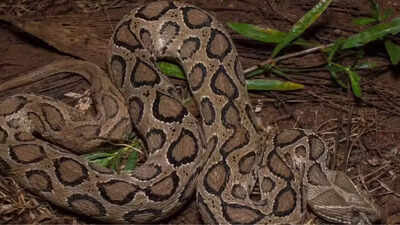ARTICLE AD BOX

From the lush rice fields of Assam to the arid landscapes of Rajasthan and the suburbs of Bengaluru, a chilling sound is sending waves of fear across India. It’s not the noise of machinery but a deadly biological signal.
The hiss of the Russell’s Viper, one of India’s most venomous snakes, has earned the eerie nickname “Whistle of Death” for its uncanny similarity to a pressure cooker whistle. Far from a harmless sound, this hiss is a life-threatening warning, often heard moments before a fatal strike. With thousands of snakebite deaths reported annually in India, the rising encounters with this stealthy predator are sparking concern among rural communities and health workers alike.
What is the "Whistle of Death"? A hissing sound that signals danger
The Russell’s Viper (Daboia russelii) produces a distinct hissing noise when it feels threatened, often described as sounding like a pressure cooker releasing steam. For locals in affected areas, this noise is no longer a curious phenomenon—it’s a life-or-death alert.Unlike a traditional snake hiss, the viper’s sound is loud, sharp, and sudden. In quiet rural areas, especially during monsoon season when ambient noise drops, this hiss cuts through the silence like an alarm bell.
Locals have quickly learned that hearing it means only one thing—get away immediately.https://www.instagram.com/reel/DGQhcVJIwl_/
Russell’s Viper: One of India’s ‘big four’ deadliest snakes
This species is not rare; it is widely distributed across India, Sri Lanka, Nepal, and parts of Southeast Asia. It belongs to the feared “Big Four” snakes in India—the group responsible for the majority of fatal snakebites. The others include the Indian Cobra, Common Krait, and Saw-scaled Viper.Russell’s Viper thrives in environments close to human habitation—farmlands, grasslands, and even suburban fringes—mainly because its primary prey is rodents, which flourish near people.
How deadly is Russell’s Viper venom
The snake’s venom is hemotoxic, meaning it attacks the blood and surrounding tissues. Victims can suffer from:
- Severe internal bleeding
- Hemorrhage and blood clotting
- Acute kidney failure
- Muscle breakdown
- Organ damage
Just 40 mg of venom is enough to kill an adult human—and a single bite from an adult viper can deliver over three times that amount.
Tragic real-life encounters highlight the threat
The deadly impact of the Russell’s Viper isn’t just theoretical—it’s being felt on the ground.In Sonitpur district of Assam, a 13-year-old boy tragically died after being bitten. He heard the hiss and instinctively ran, not realizing that physical exertion accelerates the spread of venom through the bloodstream.Similar incidents are being reported from Karnataka and Rajasthan, with hospitals noting a rise in snakebite cases—many attributed to the Russell’s Viper, especially during the monsoon when snakes emerge from flooded burrows.
Monsoon season increases Russell’s Viper activity
The monsoon rains drive snakes out of their hiding places and into open areas or human settlements. Waterlogged fields, homes, and barns become unexpected resting spots for vipers. The combination of flooded terrain, poor visibility, and barefoot villagers increases the risk of accidental encounters.According to herpetologists, Russell’s Viper doesn’t actively chase humans. However, it is extremely defensive and quick to react when it feels threatened.Before striking, it:
- Coils into an S-shape
- Raises its head and upper body
- Emits a loud, whistling hiss
This is its last warning before it attacks—its version of a biological siren urging potential threats to back off.
Viral videos spread awareness of the ‘Whistle of Death’
Wildlife expert Adil Khan, who documents snake encounters, recently posted a video of a Russell’s Viper hissing loudly in a quiet village. The post went viral on Instagram, bringing national attention to how terrifying and intense the sound can be, especially for those living in vulnerable, rural areas.
What to do if you hear the Viper’s hiss
Experts strongly advise the following:
- Do not investigate the source of the hiss
- Back away calmly and swiftly
- Do not try to capture or kill the snake
- Alert local authorities or forest department personnel if sighted
If bitten:
- Avoid running
- ImmobiliSe the limb
- Reach a medical facility as fast as possible
- Do not use traditional remedies—only antivenom can save a life
Urgent need for public awareness
With the increase in Russell’s Viper sightings and snakebite cases, especially during the monsoon, there’s a growing demand for:
- Community education about snake safety
- Emergency antivenom stockpiles in rural hospitals
- Trained personnel in local clinics
- Awareness programs in schools and villages
Most snakebite fatalities in India are preventable. The real challenge is timely access to treatment, particularly in remote areas. Respect the hiss. Spread awareness. Stay alert.Also Read | Female anaconda kills mating partner in rare ritual caught on camera; the reason might surprise you



.png)
.png)
.png)
















 3 hours ago
3
3 hours ago
3









 English (US) ·
English (US) ·